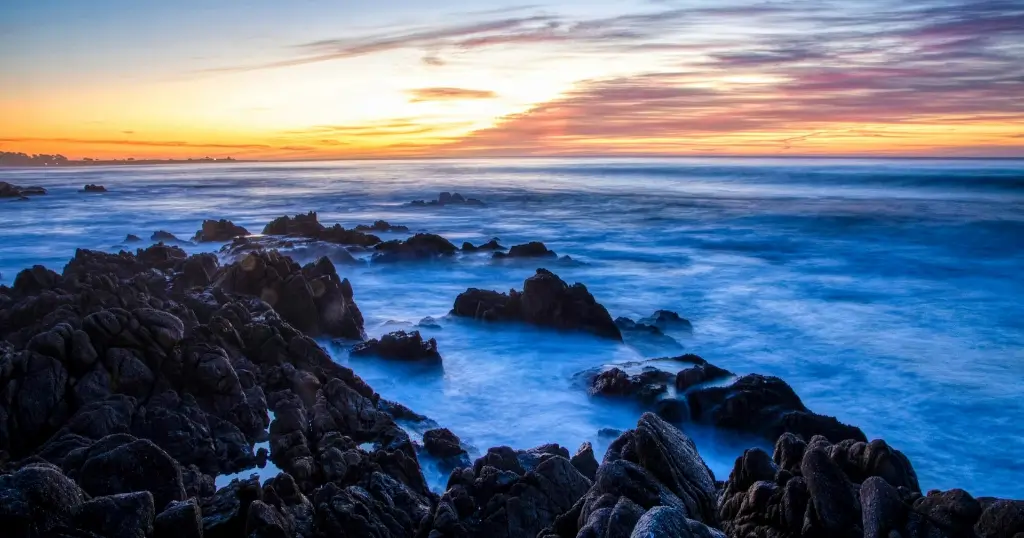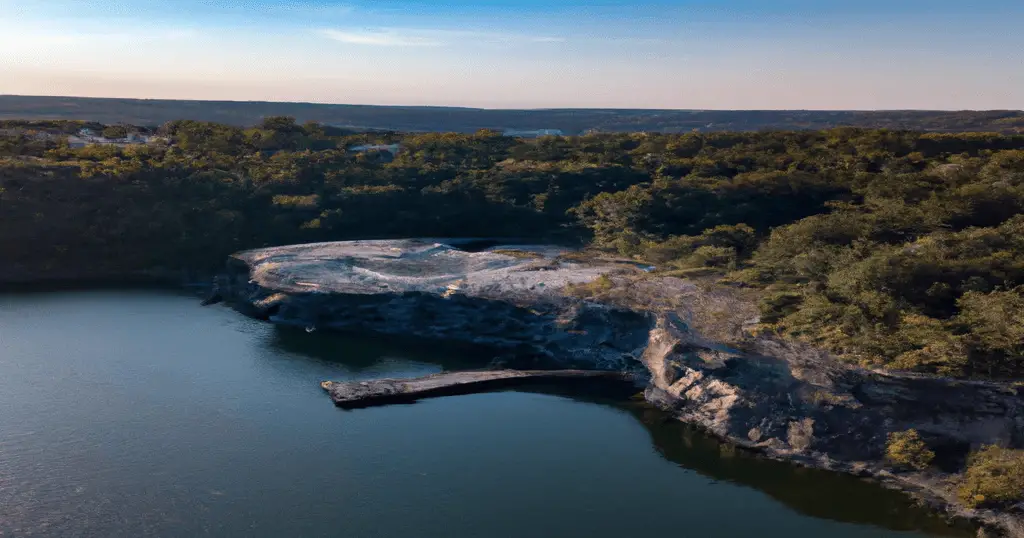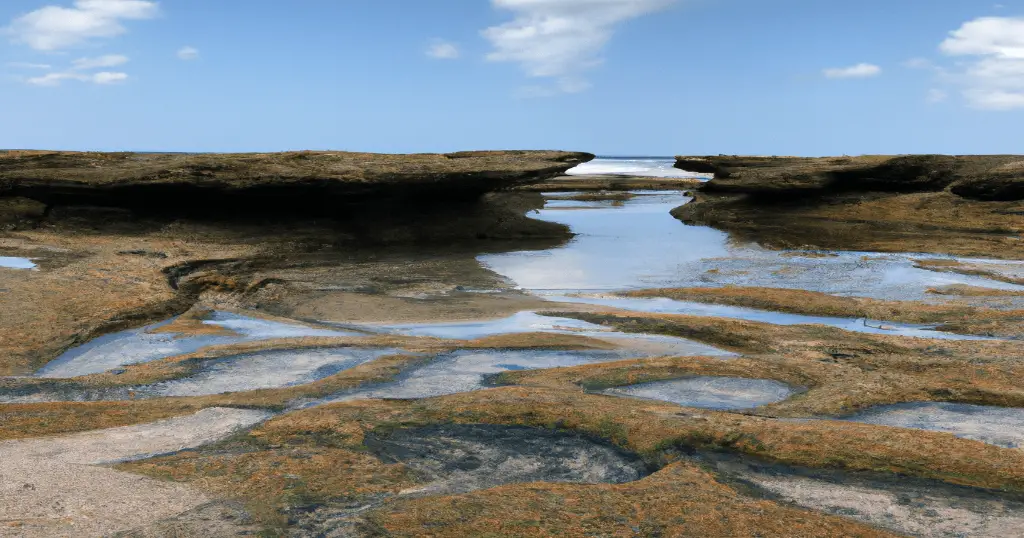The coast of Central California is an idyllic place to reconnect with nature. Particularly, the area around Monterey is sprawling with outlandish marine life. During low tide, the local beaches in the area often leave rocky outcrops exposed and tide pools ready to be explored. Tide pooling at these locations is an immersive, family-friendly outdoor activity. You get some exercise while breathing the freshest ear and learning first-hand about ecology and marine biology. During our road trip, we visited several tide pools, but the following 5 are the only ones we would recommend to anyone.
Our favorite tide pools in Monterey County
The tide pools along Monterey County’s idyllic coast are teeming with marine life. Even in the area surrounding these pools, you can spot many fascinating animals if you take your time. The tide pools are spread all around the shoreline of the Monterey Peninsula. The 5 tide pools we want to show you today are all easily accessible. Some of them are free, and some of them charge an entrance fee. They all strictly forbid collecting organisms or inorganic material (except sea glass).
If you only have time to visit two locations, we would recommend Point Pinos and Point Lobos, as they are very different and complement each other well.
1. Point Pinos (The Great Tide Pool)
Point Pinos is home to one of the oldest lighthouses of the pacific, but don’t let it distract you from what’s happening on the ground of this beautiful area. Point Pinos is also known as The Great Tide Pool. A famous scientist, Ed Rickett, spent many days studying these tide pools, as they are one of the most diverse habitats worldwide! There is also a charming boardwalk built over the dunes, from where you can look over the tide pools! As you can imagine, an area that offers this much to visitors can get very crowded.
The name the Great Tide Pool is slightly misleading, as it is not just one tide pool. Instead, it is a vast area consisting of rocky outcrops in the intertidal zone that goes around the entire shore of the peninsula. Usually, tide pools can only be seen at low tide, but Point Pinos is a rare exception. You can even check out the tide pools during high tide, although you likely won’t spot as many animals.
Animals and plants you can spot here
- Orange and blue starfish
- Hermit crabs
- Anemones (not as colorful as in other places, though)
- Skeletons of sea urchins and crabs
- Colorful varieties of giant crabs (orange, purple, blue, you name it!)
- Chitons
- Barnacles
- Limpets
- Plenty of beautiful shells
- Snails
On the beach and in the dunes around the tide pools, you may also spot seals, rare birds, herons, beach squirrels, otters and hundreds of beached jellyfish. Offshore you may be able to see some humpback whales and dolphins in the distance.
Amenities
- Clean public restrooms near the lighthouse
- No picnic tables, but plenty of nice grassy areas for a picnic.
- Benches near the heart-shaped rock
- Free parking
- Boardwalk
Additional info
- Dogs are prohibited on the lighthouse grounds
- Drones are forbidden
- Dress in layers. The lighthouse area is exposed to coastal winds.
- Sneaker waves are a daily occurrence here. Never turn your back towards the ocean while the tide is pooling.
Other recommended activities
- Visiting the lighthouse (Open from 1 to 4 pm except for Tuesday and Wednesday – 5$ per adult)
- Visit the Monterey Bay Aquarium (a 10-minute drive)
- Hike between the tide pools
- Walk the Asilomar Trails towards Asilomar State Beach (its #2 on our list anyway!)
- Play Golf at The Links
Getting there
The Great Tide Pool can be reached within 15 minutes from downtown Monterey and is located right across the Point Pinos Lighthouse. Parking is entirely free, and there are plenty of parking areas along Ocean View Boulevard. If you don’t like walking too far, we suggest parking here:
Once you’ve parked there, take a short walk towards the south along the shore. You will see the first tide pools on your right. There are plenty of well-maintained paths and stairs that lead down to various tide pools. Once you’re at the following location, you will be virtually surrounded by tide pools!
If you continue walking towards the south from there, the landscape will become flatter. There will be fewer tide pools and more sand.
2. Asilomar State Beach
Asilomar State Beach is within walking distance from Point Pinos. While this mile-long beach is more sandy, there are also some rocky coves with tide pools located on the beach’s flanks. The sand here is also quite unique. Unlike other beaches on the pacific coast, the sand on Asilomar State Beach is almost white.
These tide pools are equally spectacular, but compared to Point Pinos, they are only visible during low tide. Unfortunately, some tide pools are covered in plenty of dead algae that attracts bugs.
Animals, plants, and shells you can spot here
Just like Point Pinos, the area around Asilomar State Beach is thriving with marine life.
The tide pools at Asilomar State Beach are full of marine life. You’ll find sea urchins, sand dollars, and anemones.
- Sea urchins
- Anemones
- Orange starfish
- Fossilized corals
- Sand dollars
- Shark teeth
Humpback whales, dolphins, seals, vultures, sea otters, and gray whales can also sometimes be seen from the shore.
Amenities
- Free parking
- Boardwalk that is dotted with picnic tables and trash bins
- Lifeguard tower available, but often no lifeguards on duty
- The beach itself doesn’t have restrooms or picnic tables
- The nearest public restroom is in the Phoebe Hearst Social Hall across the street
Additional info
- Dogs are allowed but need to be on leash
- Alcohol, fires, camping, fishing or collecting animals, plants or other material of any kind is forbidden in the entire reserve
- Cycling on the boardwalk is prohibited
- Every year, people die here because of rogue waves. Don’t get too distracted by all the stunning animals in the tide pools!
- Beach wheelchairs and walkers can be borrowed at Phoebe Hearst Social Hall
Other recommended activities
- Parking is free
- Sunbathing
- Walking your dogs
- Surfing
- Hike the Asilomar Coast Trail. It starts on the northern flank of the beach and is less than a mile long. It is also wheelchair friendly.
Getting there
From downtown Monterey or the Monterey Bay Aquarium, it will take you slightly over 10 minutes to reach Asilomar Beach by car. If you come from the south via. 17-Mile Drive, beware that this is a toll road. You will have to fork over $10, even though Asilomar State Beach and Sunset Drive are free to access.
In theory, visiting the beach should be a seamless experience, as it can be easily accessed from the roadside parking spots at Sunset Drive. In reality, it can be extremely difficult to find a parking spot here. When we arrived at Sunset Drive at 10 am, the local surfers occupied all the parking spots, and we had to return later in the afternoon to be able to visit the beach. If you plan to watch the sunset here, you should come in the afternoon or at least 2 hours before. If you get lucky, you can view the sunset in your car!
Please don’t park on the pavement or block the bike lane. You will risk the lives of other drivers and cycles and also risk getting a hefty fine!
3. Point Lobos State Natural Reserve
Point Lobos is a spectacular coastal area with dramatic sunsets. The area is renowned for its wildlife, hiking, and museum. It is one of the most popular reserves and an obligatory stop on any Pacific Coast road trip itinerary.
While there are dozens of tide pools scattered all across the reserve, the most accessible ones can be found along the south shore at Weston Beach Point. Docents also offer tide pool walks here. In our opinion, these walks are much more educational and fun than the Monterey Bay Aquarium, which costs $50 per person. They are also entirely free, but afterwards, you will likely feel like tipping them. The docents are not only passionate about ecology and educating tourists about the local wildlife but also provide telescopes or binoculars to see birds and marine animals offshore.
Animals and plants you can spot here
The animals we saw at these tide pools were nothing out of the ordinary. This location may be more picturesque, but we thought Point Pinos was the superior tide-pooling location.
- Sea hares
- Octopus
- Starfish
- Chitons
- Anemones
Fortunately, the nature beyond the tide pools is more diverse. We spotted rare plants, harbor seals, sea lions, sea otters, and various birds, such as Oystercatchers, seagulls, albatrosses, pelicans, and cormorants.
Amenities
- Bathrooms are only at the front entrance and the information station. But both are clean and have soap and paper towels
- The trails are well-marked but are not wheelchair friendly
- Picnic tables are available at the bird rock
- Information desk
Additional info
Point Lobos is incredibly popular, so of course, there are plenty of rules and regulations. These are strictly enforced by the rangers.
- Dogs are forbidden
- Cycling is only allowed on the pavement
- Longboarding is forbidden everywhere
- Smoking and campfires are forbidden
- Drones are forbidden
- No campground available, and no camping allowed.
- Swimming is forbidden here unless you have a scuba certification
- Check out the reserve’s official info page here
- Dress in layers and preferably long pants, as there is plenty of poison oaks.
- The birds here are very entertaining to watch. Especially during lunchtime. Bring your binoculars and telephoto lens
- The reserve also has its own smartphone app that provides a virtual walk through the reserve. It’s filled to the brim with educational info. Our kids loved learning about the place in the car on the way to Point Lobos. Here is the Android version. And here is the iOS version.
Other recommended activities
- Scuba diving
- Chatting with docents
- Picnicking
- Painting
- Jogging
- Visiting the whaling museum nearby
- Walking to sea lion point.
Getting there
Driving from downtown Monterey to the reserve entrance will take around 15 minutes by car. Once you’re there, you must enter through the front gate between 8 am and 4:30 pm (closing time: 5 pm). But we recommend coming at least 2 hours before closing time to make the drive and entrance fee worthwhile. The entrance fee was $10 per passenger (can be paid via cash and card). Like many popular tide pooling areas along the Pacific Coast Trial, the parking opportunities are severely limited (only around 120 parking lots are available), and even the street-side parking spots are often fully occupied, especially on weekends. Even on a Friday at 10:30 am, there was already no parking space available.
If you’re visiting primarily to check out the tide pools, try scoring a parking spot at this parking lot.
From there, the best tide pools of the reserve are only a hundred feet away!
4. McAbee Beach
McAbee Beach is located in downtown Monterey, but despite the vicinity to human everyday life, the beach offers an immersive experience with plenty of animals. If you don’t feel like spending $50 to explore the Monterey Bay Aquarium, this beach is a viable alternative just a few hundred feet away! This beach is well protected from the winds and oceanic swells. Therefore, it is one of the rare tide pooling locations where you can also swim with kids. The local kids love to collect sea glass here, which is a great crafting material for school projects.
During high tides, this beach is very small, but during low tides, mother nature shows her generosity! Plenty of tide pools will become exposed to fresh air and are ready to be explored by curious folks like yourself!
Animals and plants you can spot here
The animals we saw here were only a handful of anemones and sea stars, and thus not enough to make a bullet point list. It is not a great tide pool location, but a convenient one due to its vicinity to the town of Monterey.
Most of the action here is outside the tide pools. Sea lions often sunbathe on the rocks to the left. Divers can expect to find colorful nudibranchia, some rare fishes, sea lions, and crustaceans in the kelp forest offshore.
Amenities
- Wheelchair friendly walkways are available to, and from the beach
Additional info
- The seagulls here are very aggressive, so keep your fries safe!
Other recommended activities
- Strolling around town
- Diving (We recommend only diving there when the visibility is greater than 20)
- Kayaking
- Swimming
- Combing for sea glass
Getting there
There are plenty of parking opportunities within walking distance to the beach. If you’re visiting McAbee Beach on the weekend, you may have difficulties finding one. You can try the parking lot across the street. Parking is not free.
5. Lover’s Point Beach
Lover’s point is another hotspot in Pacific Cove. It is a small peninsula that’s only a few hundred feet wide, but it offers plenty of fun for tourists and definitely worth a stop. The locals come here to swim, surf, and kayak. The tourists mainly come here for the stunning views of Monterey Bay and renting bicycles.
One activity that is enjoyed by most tourists and locals alike is tide pooling at Lover’s Point Beach. Lover’s Point Beach is protected from the ocean swells as it sits in the shadow of Point Pinos. The craggy rocks lie exposed during low tide and can be easily explored by families. Overall, you should plan to spend an hour exploring Lover’s Point Park and its tide pools. Plan a little extra time if your kids plan on swimming in the dedicated swimming pool!
Animals and plants you can spot here
- Hermit crabs
- Star fish
- Sea urchins
- Anemones
- Small crabs
- Mussels
- Lots of kelp
You also stand a good chance of spotting whales breaching in the distance. Sea otters and harbor seals are also not a rare occurrence. There is a gang of western gray squirrels in the park that seemingly is not aware of the concept of personal space. They obviously get fed by tourists.
Amenities
- You can rent: boats, surfboards, SUPs, kayaks, and bicycles
- A snack bar
- A volleyball court
- A kid’s swimming pool
- The cafés within walking distance are open between 9 am and 4 pm
- Picnic tables and BBQ areas are located in the park, but not available on the beach
- Restrooms and a changing room
- No lifeguard on duty
Additional info
- Drones are prohibited
- Dogs are prohibited on the beach, but allowed in the park
- Please do not feed the squirrels at the park. They are already way too fat!
Other recommended activities
- Boating
- Swimming
- Kayaking to otter cove
- Surfing
- Picnicking
- BBQing
- Diving
- Birdwatching
- Dining in the restaurants nearby
- Taking a leisurely walk and marvel at the million dollar homes there
- Sunbathing
Getting there
Lover’s Point Beach can be reached from downtown Monterey within 10 minutes. The parking lot is rarely at total capacity, and the first 2 hours of parking are completely free! The best tide pools are on the north shore of the peninsula, but climbing down there can be a tad tricky.



